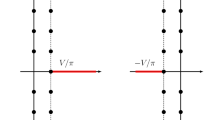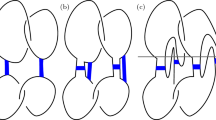Abstract
We present a simple phenomenological formula which approximates the hyperbolic volume of a knot using only a single evaluation of its Jones polynomial at a root of unity. The average error is just 2.86% on the first 1.7 million knots, which represents a large improvement over previous formulas of this kind. To find the approximation formula, we use layer-wise relevance propagation to reverse engineer a black box neural network which achieves a similar average error for the same approximation task when trained on 10% of the total dataset. The particular roots of unity which appear in our analysis cannot be written as e2πi/(k+2) with integer k; therefore, the relevant Jones polynomial evaluations are not given by unknot-normalized expectation values of Wilson loop operators in conventional SU(2) Chern-Simons theory with level k. Instead, they correspond to an analytic continuation of such expectation values to fractional level. We briefly review the continuation procedure and comment on the presence of certain Lefschetz thimbles, to which our approximation formula is sensitive, in the analytically continued Chern-Simons integration cycle.
Article PDF
Similar content being viewed by others
Avoid common mistakes on your manuscript.
References
L. J. Dixon, Some worldsheet properties of superstring compactifications, on orbifolds and otherwise, in Summer Workshop in High-energy Physics and Cosmology, (1987) PUPT-1074.
W. Lerche, C. Vafa and N. P. Warner, Chiral Rings in N = 2 Superconformal Theories, Nucl. Phys. B 324 (1989) 427 [INSPIRE].
P. Candelas, M. Lynker and R. Schimmrigk, Calabi-Yau Manifolds in Weighted P(4), Nucl. Phys. B 341 (1990) 383 [INSPIRE].
B. R. Greene and M. R. Plesser, Duality in Calabi-Yau Moduli Space, Nucl. Phys. B 338 (1990) 15 [INSPIRE].
P. Candelas, X. C. De La Ossa, P. S. Green and L. Parkes, A Pair of Calabi-Yau manifolds as an exactly soluble superconformal theory, Nucl. Phys. B 359 (1991) 21 [AMS/IP Stud. Adv. Math. 9 (1998) 31] [INSPIRE].
A. Givental, A mirror theorem for toric complete intersections, in Topological field theory, primitive forms and related topics, Springer (1998), pp. 141–175.
B. H. Lian, K. F. Liu and S.-T. Yau, Mirror principle. 1., Asian J. Math. 1 (1997) 729 [INSPIRE].
V. F. R. Jones, Hecke algebra representations of braid groups and link polynomials, Annals Math. 126 (1987) 335 [INSPIRE].
W. Thurston, The Geometry and Topology of 3-Manifolds, Lecture Notes, Princeton University, New Jersey U.S.A. (1978).
E. Witten, Quantum Field Theory and the Jones Polynomial, Commun. Math. Phys. 121 (1989) 351 [INSPIRE].
R. M. Kashaev, The Hyperbolic volume of knots from quantum dilogarithm, Lett. Math. Phys. 39 (1997) 269 [INSPIRE].
H. Murakami and J. Murakami, The colored Jones polynomials and the simplicial volume of a knot, Acta Math. 186 (2001) 85 [math/9905075].
S. Gukov, Three-dimensional quantum gravity, Chern-Simons theory, and the A polynomial, Commun. Math. Phys. 255 (2005) 577 [hep-th/0306165] [INSPIRE].
N. Dunfield, An interesting relationship between the Jones polynomial and hyperbolic volume, (2000) https://faculty.math.illinois.edu/∼nmd/preprints/misc/dylan/index.html.
S. Garoufalidis and Y. Lan, Experimental evidence for the volume conjecture for the simplest hyperbolic non-2-bridge knot, Algebr. Geom. Topol. 5 (2005) 379 [math/0412331].
V. Jejjala, A. Kar and O. Parrikar, Deep Learning the Hyperbolic Volume of a Knot, Phys. Lett. B 799 (2019) 135033 [arXiv:1902.05547] [INSPIRE].
L. G. Valiant, A theory of the learnable, Commun. ACM 27 (1984) 1134.
E. Witten, Analytic Continuation Of Chern-Simons Theory, AMS/IP Stud. Adv. Math. 50 (2011) 347 [arXiv:1001.2933] [INSPIRE].
W. P. Thurston, Three-Dimensional Geometry and Topology, Princeton University Press, (1997).
V. Balasubramanian, J. R. Fliss, R. G. Leigh and O. Parrikar, Multi-Boundary Entanglement in Chern-Simons Theory and Link Invariants, JHEP 04 (2017) 061 [arXiv:1611.05460] [INSPIRE].
V. Balasubramanian, M. DeCross, J. Fliss, A. Kar, R. G. Leigh and O. Parrikar, Entanglement Entropy and the Colored Jones Polynomial, JHEP 05 (2018) 038 [arXiv:1801.01131] [INSPIRE].
T. Dimofte and S. Gukov, Quantum Field Theory and the Volume Conjecture, Contemp. Math. 541 (2011) 41 [arXiv:1003.4808] [INSPIRE].
Y. LeCun, Y. Bengio and G. Hinton, Deep learning, Nature 521 (2015) 436.
M. C. Hughes, A neural network approach to predicting and computing knot invariants, (2016) arXiv:1610.05744.
S. Gukov, J. Halverson, F. Ruehle and P. Sułkowski, Learning to Unknot, Mach. Learn. Sci. Tech. 2 (2021) 025035 [arXiv:2010.16263] [INSPIRE].
G. Cybenko, Approximation by superpositions of a sigmoidal function, Math. Control Signals Syst. 2 (1989) 303.
K. Hornik, Approximation capabilities of multilayer feedforward networks, Neural Networks 4 (1991) 251.
J. Hoste, M. Thistlethwaite and J. Weeks, The first 1,701,936 knots, Math. Intelligencer 20 (1998) 33.
The knot atlas: The take home database, www.katlas.org/wiki/The_Take_Home_Database.
M. Culler, N. M. Dunfield, M. Goerner and J. R. Weeks, SnapPy, a computer program for studying the geometry and topology of 3-manifolds, http://snappy.computop.org.
S. Bach, A. Binder, G. Montavon, F. Klauschen, K.-R. Müller and W. Samek, On pixel-wise explanations for non-linear classifier decisions by layer-wise relevance propagation, PloS one 10 (2015) e0130140.
G. Montavon, A. Binder, S. Lapuschkin, W. Samek and K.-R. Müller, Layer-wise relevance propagation: An overview, in Explainable AI: Interpreting, Explaining and Visualizing Deep Learning, Springer (2019) [DOI].
O. Dasbach and X.-S. Lin, A volumish theorem for the jones polynomial of alternating knots, Pacific J. Math. 231 (2007) 279.
S.-M. Udrescu and M. Tegmark, AI Feynman: a Physics-Inspired Method for Symbolic Regression, Sci. Adv. 6 (2020) eaay2631 [arXiv:1905.11481] [INSPIRE].
S. Blücher, L. Kades, J. M. Pawlowski, N. Strodthoff and J. M. Urban, Towards novel insights in lattice field theory with explainable machine learning, Phys. Rev. D 101 (2020) 094507 [arXiv:2003.01504] [INSPIRE].
J. S. Cotler et al., Black Holes and Random Matrices, JHEP 05 (2017) 118 [Erratum ibid. 09 (2018) 002] [arXiv:1611.04650] [INSPIRE].
G. W. Moore, Introduction to Chern-Simons theories, lecture notes for a series of talks at the 2019 TASI school, (2019) http://www.physics.rutgers.edu/∼gmoore/TASI-ChernSimons-StudentNotes.pdf.
M. Khovanov, Patterns in knot cohomology, I, Exper. Math. 12 (2003) 365.
K. Habiro, On the colored jones polynomials of some simple links, Sūrikaisekikenkyūsho Kōkyūroku, Kyoto University, Kyoto (2000).
D. Bar-Natan, The symbol font dbnsymb, (2020) https://www.math.toronto.edu/∼drorbn/projects/dbnsymb/dbnsymbman.html.
M. Abadi et al., TensorFlow: Large-Scale Machine Learning on Heterogeneous Distributed Systems, arXiv:1603.04467 [INSPIRE].
Y.-H. He, Deep-Learning the Landscape, arXiv:1706.02714 [INSPIRE].
F. Ruehle, Evolving neural networks with genetic algorithms to study the String Landscape, JHEP 08 (2017) 038 [arXiv:1706.07024] [INSPIRE].
D. Krefl and R.-K. Seong, Machine Learning of Calabi-Yau Volumes, Phys. Rev. D 96 (2017) 066014 [arXiv:1706.03346] [INSPIRE].
J. Carifio, J. Halverson, D. Krioukov and B. D. Nelson, Machine Learning in the String Landscape, JHEP 09 (2017) 157 [arXiv:1707.00655] [INSPIRE].
K. Bull, Y.-H. He, V. Jejjala and C. Mishra, Machine Learning CICY Threefolds, Phys. Lett. B 785 (2018) 65 [arXiv:1806.03121] [INSPIRE].
K. Bull, Y.-H. He, V. Jejjala and C. Mishra, Getting CICY High, Phys. Lett. B 795 (2019) 700 [arXiv:1903.03113] [INSPIRE].
Y.-H. He and S.-T. Yau, Graph Laplacians, Riemannian Manifolds and their Machine-Learning, arXiv:2006.16619 [INSPIRE].
Y.-H. He and A. Lukas, Machine Learning Calabi-Yau Four-folds, Phys. Lett. B 815 (2021) 136139 [arXiv:2009.02544] [INSPIRE].
J. Halverson, B. Nelson and F. Ruehle, Branes with Brains: Exploring String Vacua with Deep Reinforcement Learning, JHEP 06 (2019) 003 [arXiv:1903.11616] [INSPIRE].
J. Halverson, M. Plesser, F. Ruehle and J. Tian, Kähler Moduli Stabilization and the Propagation of Decidability, Phys. Rev. D 101 (2020) 046010 [arXiv:1911.07835] [INSPIRE].
J. Halverson and C. Long, Statistical Predictions in String Theory and Deep Generative Models, Fortsch. Phys. 68 (2020) 2000005 [arXiv:2001.00555] [INSPIRE].
M. Bies, M. Cvetič, R. Donagi, L. Lin, M. Liu and F. Ruehle, Machine Learning and Algebraic Approaches towards Complete Matter Spectra in 4d F-theory, JHEP 01 (2021) 196 [arXiv:2007.00009] [INSPIRE].
F. Ruehle, Data science applications to string theory, Phys. Rept. 839 (2020) 1 [INSPIRE].
C. R. Brodie, A. Constantin, R. Deen and A. Lukas, Machine Learning Line Bundle Cohomology, Fortsch. Phys. 68 (2020) 1900087 [arXiv:1906.08730] [INSPIRE].
C. R. Brodie, A. Constantin, R. Deen and A. Lukas, Topological Formulae for the Zeroth Cohomology of Line Bundles on Surfaces, arXiv:1906.08363 [INSPIRE].
C. R. Brodie, A. Constantin, R. Deen and A. Lukas, Index Formulae for Line Bundle Cohomology on Complex Surfaces, Fortsch. Phys. 68 (2020) 1900086 [arXiv:1906.08769] [INSPIRE].
M. Khovanov, A categorification of the Jones polynomial, Duke Math. J. 101 (2000) 359 [math/9908171] [INSPIRE].
D. Bar-Natan, On khovanov’s categorification of the jones polynomial, Algebr. Geom. Topol. 2 2 (2002) 337 [math/0201043].
L. H. Kauffman, State models and the jones polynomial, Topology 26 (1987) 395.
K. P. Walsh, Patterns and Stability in the Coefficients of the Colored Jones Polynomial, Ph.D. Thesis, University of California, San Diego (2014) https://roger.ucsd.edu:443/record=b8201173∼S9.
K. P. Walsh, Higher order stability in the coefficients of the colored jones polynomial, J. Knot Theor. Ramifications 27 (2018) 1840010 [arXiv:1603.06957].
T. T. Lê, The colored jones polynomial and the aj conjecture, (2014) http://people.math.gatech.edu/∼letu/Papers/Lectures_Luminy_2014_new.pdf.
V. F. Jones, The jones polynomial for dummies, (2014) math.berkeley.edu/∼vfr/jonesakl.pdf.
V. F. Jones, The jones polynomial, (2005) https://math.berkeley.edu/∼vfr/jones.pdf.
H. Murakami, J. Murakami, M. Okamoto, T. Takata and Y. Yokota, Kashaev’s conjecture and the Chern-Simons invariants of knots and links, Exper. Math. 11 (2002) 427.]
L. van der Maaten and G. Hinton, Visualizing data using t-SNE, J. Mach. Learn. Res. 9 (2008) 2579.
F. Pedregosa et al., Scikit-learn: Machine learning in Python, J. Mach. Learn. Res. 12 (2011) 2825.
P. Fréyd, D. Yetter, J. Hoste, W. B. R. Lickorish, K. Millett and A. Ocneanu, A new polynomial invariant of knots and links, Bull. Am. Math. Soc. 12 (1985) 239 [INSPIRE].
J. H. Przytycki and P. Traczyk, Conway algebras and skein equivalence of links, Proc. Am. Math. Soc. 100 (1987) 744.
J. W. Alexander, Topological invariants of knots and links, Trans. Am. Math. Soc. 30 (1928) 275.
M. Cranmer et al., Discovering Symbolic Models from Deep Learning with Inductive Biases, arXiv:2006.11287 [INSPIRE].
M. Cranmer, Pysr: Fast & parallelized symbolic regression in python/julia, September 2020, https://doi.org/10.5281/zenodo.4052869.
Author information
Authors and Affiliations
Corresponding author
Additional information
Publisher’s Note
Springer Nature remains neutral with regard to jurisdictional claims in published maps and institutional affiliations.
ArXiv ePrint: 2012.03955
Rights and permissions
Open Access . This article is distributed under the terms of the Creative Commons Attribution License (CC-BY 4.0), which permits any use, distribution and reproduction in any medium, provided the original author(s) and source are credited.
About this article
Cite this article
Craven, J., Jejjala, V. & Kar, A. Disentangling a deep learned volume formula. J. High Energ. Phys. 2021, 40 (2021). https://doi.org/10.1007/JHEP06(2021)040
Received:
Revised:
Accepted:
Published:
DOI: https://doi.org/10.1007/JHEP06(2021)040




